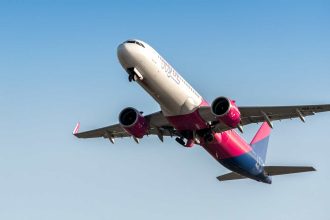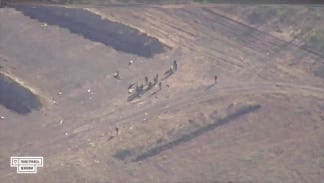Incredibly, it happened again. Russian troops gathered for training out in the open within range of Ukraine’s best artillery, apparently in Zaporizhzhia Oblast in Russian-occupied southern Ukraine.
A Ukrainian drone spotted the trainees and relayed the coordinates to a Ukrainian High Mobility Artillery Rocket System battery. A 660-pound rocket packed with hundreds of grenade-sized submunitions streaked down, peppering the Russians with lethal fragments.
The Wednesday strike on Russian forces in Zaporizhzhia came just days after a separate Ukrainian raid on Russian trainees in the same oblast. Altogether, there have been no fewer than seven raids on Russian trainees all along the 700-mile front line since February. Potentially hundreds of Russians have died.
Like the strike that preceded it, the most recent Ukrainian strike targeted Russian troops at what appears to be a shooting range. As a Ukrainian drone watched from overhead, dozens of Russians gathered in broad daylight on a clear day.
A Ukrainian rocket, apparently an American-made M30/31 packing 400 bomblets, scored a direct hit. The drone lingered, observing the Russian survivors—and the Russian bodies.
The raid says as much about Ukraine’s growing deep-strike capabilities as it does about Russian commanders’ negligence in attempting to conduct training within the 57-mile range of the GPS-guided M30/31 rockets.
The drone that provided the intelligence for the Wednesday raid reportedly belonged to the Black Forest drone group, which operates Ukrainian-made Shark unmanned aerial vehicles. “Artillery has radically transformed thanks to UAVs,” a Black Forest sergeant named Petro told Ukrainian Pravda.
“Before drones appeared, artillery and multiple-launch rocket systems were used in batteries of six to 12 machines to simply bombard entire areas,” Petro said. “Now, the launchers and guns fire one by one, because UAVs allow for precise fire adjustment.”
As recently as September, the Black Forest group was in Pokrovsk, a fortress city in eastern Ukraine. Launching the 28-pound, camera-equipped Sharks from Pokrovsk, the group helped hunt down Russian air defense batteries protecting the assault groups attacking toward the city.
This week’s strike in the south seems to indicate the Black Forest group has moved to a different sector of the front line—or has at least detached some of its drones and drone operators to work in the south. For the Wednesday attack, the drone crews reportedly teamed up with the Ukrainian army’s 128th Mountain Brigade, which has been holding the line in Zaporizhzhia Oblast for a year now.
The Black Forest group’s Shark drones are recent acquisitions. Kyiv tech firm Ukrspecsystems designed the catapult-launched, propeller-driven Shark in the immediate aftermath of Russia’s wider attack on Ukraine in February 2022. The company realized its best drones, including the PD-2, were too sophisticated and expensive for the demands of a full-scale war.
“We decided to minimize the complex features we developed for the PD-2 and provide a highly simplified, mass-producible drone,” Dmytro Khasapov, the head of Ukrspecsystems, told Pravda. “However, it still needed to be of sufficient quality to perform all the tasks required for reconnaissance and artillery fire adjustment.”
Ranging as far as 50 miles under radio control, a Shark neatly matches the range of the M30/31 rocket. Shark drones and HIMARS launchers make a deadly team; together, they are extending the reach of Ukrainian strikes—and making them more precise.
Early in the war, the Black Forest group flew most of its surveillance missions within just a few miles of the front line. That’s changing. “We are actually no longer interested in a 20-kilometer [12-mile] range,” a Black Forest officer named Kostiantyn told Pravda. “Our task is, as we call it, is low deep strikes; up to 30 kilometers [19 miles] and beyond.”
The implication is that the Russian training session that got rocketed on Wednesday took place no farther than 20 miles from the front line. That’s recklessly close given how far M30/31 rockets can travel—and how deadly even one of the rockets can be against exposed troops.
Read the full article here





